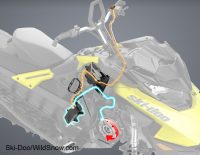This post sponsored by our publishing partner Cripple Creek Backcountry — reluctantly — they sell ski gear. Perhaps Doug and Randy will begin stocking ski racks for sleds, but then, their typical customer is in more need of new ski touring boots.
Should I be embarrassed about enjoying that first SnoWest magazine of the season, with their shiny new snowmobile reviews and other “interesting” stuffing? I don’t know. Perhaps I’ll never know. Let me get past that.
Remember a while back I reported on the (possibly revolutionary) capacitor driven electric airbag backpack that Scott is coming up with? Something must be going on with capacitors because, behold, SnoWest reports Ski-Doo will be selling sleds with what they’re calling “Shot Start.” This is also a capacitor powered system.
Shot Start works like this: You pull-start your sled once in the morning. It has to run for around 2 minutes, in turn charging the capacitor. After that, you have push-button electric start if you use within 30 minutes of engine shutdown. I love this concept, as with our style of sledding we’re constantly powering down to chat about the route, re-arrange towed skiers and other quick things that go better without a cloud of exhaust.
The system only adds 2 pounds to overall sled weight, though the reduction in wallet weight is more substantial ($600 upcharge upon new sled purchase). Sadly, Shot Start only works with one variety of Ski-Doo engine that apparently has to be closely integrated, it’s thus not a retrofit. I’d imagine if this functions close to promised performance, you’ll see on plenty of other sleds in coming years boast similar systems.
More, I can see an immediate place for aftermarket upgrades that would perhaps double capacitor charge life. At a couple of pounds stock, adding a few more pounds and doubling time allowed between starts would be brilliant. I also wonder if the Shot Start capacitor could be externally charged, thus essentially creating an electric start system if you have shore power at parking, such as cabin solar or grid.
More on the snowmobile news front:
Love ’em or hate ’em (or be you a ‘tweener), I know you’re curious just how many snowmobiles get purchased every year. SnoWest to the rescue on that, this issue has their annual report. Image below gives U.S. details. Short story: sales numbers continue to drop. Sno-West says snowfall drives sales, and last winter saw many regions with less than ideal snow. I’d venture to say that’s compounded by the fact that recreational sledding doesn’t use as much high altitude terrain as ski touring, so it’s much more sensitive to “shoulder” climate issues. In other words, if the rain line is just 500 feet higher in elevation, one wet storm could shut down an entire snowmobile trail network, while human powered snowsports are still available in alpine terrain above.
The magazine included sales numbers from of all places, Russia. Apparently some sort of collusion between snow and machine created 20,012 sales just a few years ago – dropping to just a few thousand sales for 2017. Theory is high gasoline prices shut it down. I don’t buy that. I think the Russian secret service bought 18,000 sleds for agents needing to access a secret computer facility in the far north reaches of Siberia, and with the quality of later model snowmobiles (and limited government funding) they’re not needing replacement units any time soon. Any other theories on that?
WildSnow.com publisher emeritus and founder Lou (Louis Dawson) has a 50+ years career in climbing, backcountry skiing and ski mountaineering. He was the first person in history to ski down all 54 Colorado 14,000-foot peaks, has authored numerous books about about backcountry skiing, and has skied from the summit of Denali in Alaska, North America’s highest mountain.


